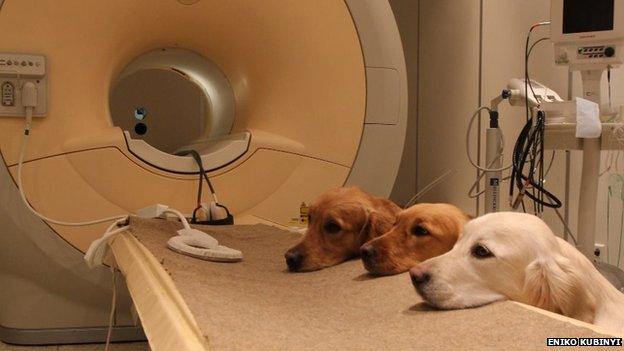Dogs' brain scans reveal vocal responses
- Published

Pet dogs took part in the MRI scanning study
Devoted dog owners often claim that their pets understand them. A new study suggests they could be right.
By placing dogs in an MRI scanner, researchers from Hungary found that the canine brain reacts to voices in the same way that the human brain does.
Emotionally charged sounds, such as crying or laughter, also prompted similar responses, perhaps explaining why dogs are attuned to human emotions.
The work is published in the journal Current Biology, external.
Lead author Attila Andics, from the Comparative Ethology Research Group at the Hungarian Academy of Sciences, said: "We think dogs and humans have a very similar mechanism to process emotional information."
Eleven pet dogs took part in the study; training them took some time.
"We used positive reinforcement strategies - lots of praise," said Dr Andics.
"There were 12 sessions of preparatory training, then seven sessions in the scanner room, then these dogs were able to lie motionless for as long as eight minutes. Once they were trained, they were so happy, I wouldn't have believed it if I didn't see it."

The canine brain reacted to voices in the same way that the human brain does
For comparison, the team looked at the brains of 22 human volunteers in the same MRI scanners.
The scientists played the people and pooches 200 different sounds, ranging from environmental noises, such as car sounds and whistles, to human sounds (but not words) and dog vocalisations.
The researchers found that a similar region - the temporal pole, which is the most anterior part of the temporal lobe - was activated when both the animals and people heard human voices.
"We do know there are voice areas in humans, areas that respond more strongly to human sounds that any other types of sounds," Dr Andics explained.
"The location (of the activity) in the dog brain is very similar to where we found it in the human brain. The fact that we found these areas exist at all in the dog brain at all is a surprise - it is the first time we have seen this in a non-primate."

The team used a variety of techniques to train the dogs
Emotional sounds, such as crying and laughter also had a similar pattern of activity, with an area near the primary auditory cortex lighting up in dogs and humans.
Likewise, emotionally charged dog vocalisations - such as whimpering or angry barking - also caused a similar reaction in all volunteers,
Dr Andics said: "We know very well that dogs are very good at tuning into the feelings of their owners, and we know a good dog owner can detect emotional changes in his dog - but we now begin to understand why this can be."
However, while the dogs responded to the human voice, their reactions were far stronger when it came to canine sounds.
They also seemed less able to distinguish between environmental sounds and vocal noises compared with humans.
About half of the whole auditory cortex lit up in dogs when listening to these noises, compared with 3% of the same area in humans.
Commenting on the research, Prof Sophie Scott, from the Institute of Cognitive Neuroscience at University College London, said: "Finding something like this in a primate brain isn't too surprising - but it is quite something to demonstrate it in dogs.
"Dogs are a very interesting animal to look at - we have selected for a lot of traits in dogs that have made them very amenable to humans. Some studies have show they understand a lot of words and they understand intentionality - pointing."
But she added: "It would be interesting to see the animal's response to words rather than just sounds. When we cry and laugh, they are much more like animal calls and this might be causing this response.
"A step further would be if they had gone in and shown sensitivity to words in the language their owners speech."
Dr Andics said this would be the focus of his next set of experiments.
Follow Rebecca on Twitter, external
- Published23 January 2013